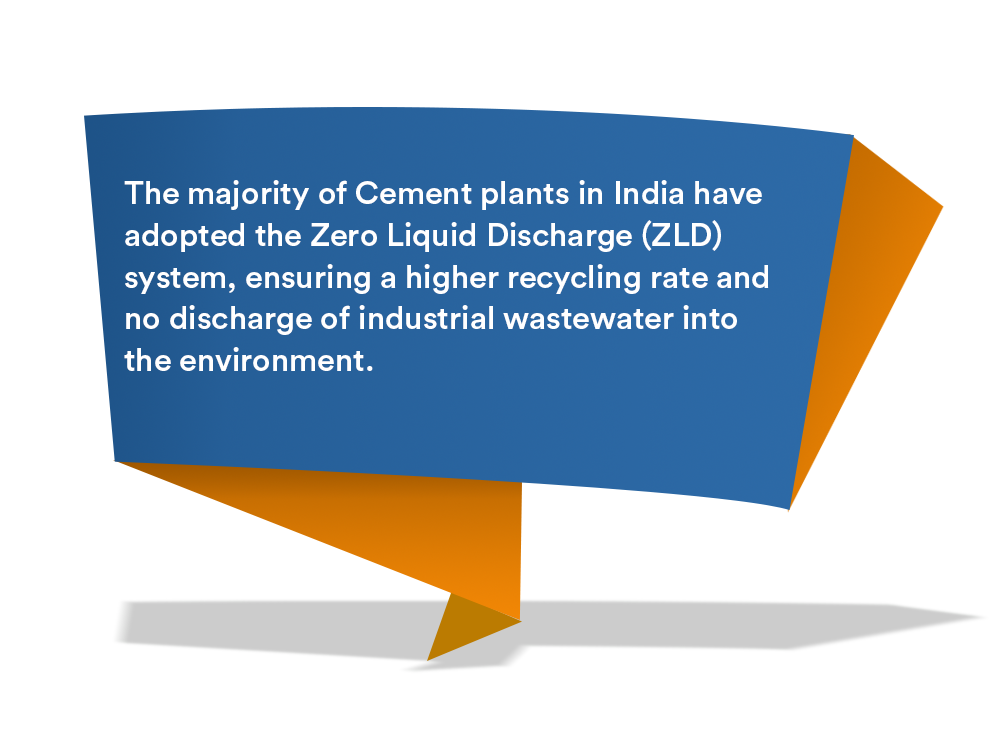India houses 16% of the global population1while having only 4% of the world’s total water resources. This disproportionate demand and availability of water often become a natural constraint for meeting the needs of a rising population and faster economic development. Agriculture is the single largest consumer of water in India followed by industry.2 Among industries, thermal power plants are highly water intensive in nature, representing almost 88% of the total industrial water use. Other Industries, including Iron and steel, paper and pulp, cement, etc. accounts for the remaining 12% of industrial water use.3
The traditional practice of cement manufacturing lends it the status of water intensive industry, owing to the wet manufacturing processes. In the wet manufacturing process, raw materials are mixed with 32%-36% water before being fed into the cement kiln.4 This, however, results in low dust, easy conveying, and better raw mix homogeneity at the cost of high energy intensity. Over time, the Indian Cement Industry recognised the challenges of limited water resources and has almost fully transitioned to the dry manufacturing processes supplemented by multiple dust control technologies. This makes the Indian Cement Industry both water and energy efficient while keeping intact the quality of the product.
Some of the prominent measures adopted by the Indian Cement Industry are detailed below:
Presently, almost 99% of the installed cement manufacturing capacity in India uses dry process manufacturing.5 A dry process kiln when fitted with a pre calciner; a multistage cyclone preheater; and a multichannel burner – leads to the best available energy performance level at 3.0-3.4 GJ/t clinker as opposed to 5.9 GJ/t to 6.7GJ/t clinker in the wet process.67
Water efficient technologies such as Air Cooled Condensers (ACC) and Waste Heat Recovery systems (WHRS) reduce the requirement of water for cooling hot air/steam from the preheater, cooler, and kiln. The majority of Cement plants in India have adopted the Zero Liquid Discharge (ZLD) system, which is a closed loop wastewater management system, ensuring a higher recycling rate and no discharge of industrial wastewater into the environment. Water efficient Captive Power Plants (CPPs) operate within the threshold of 3.5 m3/MWh set by the Ministry of Environment, Forest and Climate Change (MoEFCC).8
The energy water nexus builds a strong case for the adoption of renewable energy to meet growing electricity demand while addressing environmental and energy security objectives. The operational water withdrawal intensity of solar Photo Voltaic (PV) in India is around 0.08 m3/MWh (primarily related to panel cleaning), which is only 0.5% of the thermal average, while for wind, the water withdrawal is zero.9 Many Cement plants have been gradually increasing the share of renewable/clean energy in their portfolio.
Provisions to avoid water overflow and leakages from operational water network and judicious use/reuse of water from the cooler drain, sack wash; cooling tower blow-down; and soot blowing system improves the utilisation of water. Automatic water sprinklers and drip irrigation systems conserve water in the suppression of dust along mining roads and in horticulture. All the cement plants (excluding grinding units and bulk terminals) have implemented sewage treatment plants (STPs) to treat waste water, which is then used towards horticulture, dual flushes, and cooling towers.
The captive limestone mines backfilled pit serves as a potential rain water harvesting reservoir owing to its low permeability. The harvested rain water is utilised for cement production and irrigation in nearby villages, thereby reducing reliance on the municipal water supply and ground water. Rain water harvesting in mining pits have helped to recharge the ground water
Many Cement Companies have extensively contributed to strengthening the accessibility of clean water in the nearby villages through a series of water conservation and harvesting initiatives such as building watersheds, village ponds, bunds, check dams, wells, sprinklers, and drip irrigation among others. Some of these villages have now transitioned to two crop cycles/year from one.
Resource efficient manufacturing coupled with periodic benchmarking exercises, knowledge sharing, collaborative research and development, and target setting has enabled the Indian Cement Industry to strengthen water resilience across its operations. Improved access to water has enabled the societies in the vicinity of cement plants to generate more economic activities and lead a prosperous life. While the water demand will continue to rise with the growing population, the Cement Industry is committed to reducing its freshwater withdrawal by recycling, conserving, and harvesting water – within and beyond plant operations. All these interventions make the Indian Cement Sector a proud water positive sector.
